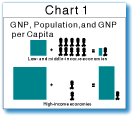|
|
| |
|
|
|
|
|
|
GNP per Capita
"For Teachers"
Teaching Activities
Gross national product (GNP) per capita is the dollar value of a country’s final output of goods and services in a year, divided by its population. It reflects the average income of a country’s citizens. Knowing a country’s GNP per capita is a good first step toward understanding its economic strengths and needs.
|
Exploring the GNP per Capita Text
1. Read the definition of GNP per capita and answer the following questions:
2. Read the definitions of low-income, middle-income and high-income countries and answer the following questions:
3. The items listed below would be included in calculating a country’s GNP. Which items are goods? Which are services?
4. Answer each of the following questions briefly, referring back to the text if necessary.
5. Calculate GNP per capita for countries A and B using this formula: GNP � Population = GNP per capita
| GNP | Population | GNP per capita | |
| Country A | $16,512,000,000 | 103,200,000 | |
| Country B | $1,560,060,000,000 | 121,500,000 |
Based on your answers, identify each country as low-income, middle-income, or high-income.
6. Use the population information in the table below to answer the question that follows.
| Percentage of total world population, 1995 |
GNP per capita, 1995 |
|
| Low-income economies | 56% | $430 |
| Middle-income economies | 28% | $2,390 |
| High-income economies | 16% | $24,930 |
How many times greater is the average GNP per capita of high-income countries than that of low-income countries?
7. Read the definition of growth rates, then calculate the annual GNP per capita growth rates for countries A and B using the following formula:
| Change in GNP per capita in a year |
� | GNP per capita at the start of the year |
x | 100 | = | Annual GNP per capita growth rate (%) |
| GNP per capita at the start of the year |
GNP per capita at the end of the year |
Changes in GNP per capita during the year |
Annual GNP per capita growth rate |
|
| Country A | $113 | $110 | ||
| Country B | $1,590 | $1,700 |
Note: Average annual growth rates of GNP per capita for a period of years provide a better picture than rates for a single year. Calculating any growth rate for a period longer than a year requires more complicated mathematical formulas than the one used to calculate an annual rate.
8. Purchasing power parity (PPP) is used to compare how much a dollar can buy in different countries. If GNP per capita goes up after being adjusted for PPP, one can buy more goods and services than the GNP per capita figure would suggest. If it goes down after adjustment, one can buy less than the figure would suggest. Look at the following table and answer the questions below.
| GNP per capita 1995 |
GNP per capita (PPP) 1995 |
|
| Country A | $17,390 | $23,790 |
| Country B | $31,250 | $27,940 |
9. Natural resource accounting tries to measure and allow for the costs of depleting natural resources and degrading the environment that can be part of economic growth. Listed below are some products that would add value to a country’s GNP. For each product, list some potential environmental and resource costs that might not be recognized in GNP, but which would be included in natural resource accounting.
| Product | Potential environmental and resource costs
|
|
Wood furniture |
Food crops |
Electricity from a coal burning plant |
| [Back to Text] | [ Top ] | [ Table of Contents ] |

Exploring the Map
1. According to the map key, which color represents low-income economies? Which color represents middle-income economies? Which color represents high-income economies?
2. Find Argentina, Germany, India, South Africa, and United Arab Emirates on the map. What income group does each country belong to? Compare the color of each country with those of its neighbors. To what extent is each country typical of conditions in its area and region?
3. Which income group is most represented in Sub-Saharan Africa? South America? North America?
| [Back to Map] | [ Top ] | [ Table of Contents ] |

Exploring Chart 1
1. Study Chart 1 which shows GNP, population, and GNP per capita for low- and middle-income and high-income countries. What does it show you about the differences in the production of goods and services between high-income countries and low- and middle-income countries?
2. Compare GNP per capita in low- and middle-income and high-income countries.
3. If a country slows down its population growth rate, is its GNP per capita likely to increase or decrease?
4. Based on the text and your own knowledge, list three possible social and three possible economic reasons for the difference in productivity between high-income and low- and middle-income countries.
| [ Back to Chart 1] | [ Top ] | [ Table of Contents ] |

Exploring Chart 2
1. Read the definition of growth rates, then use the data from Chart 2 to complete the following table:
| GNP growth rate |
Population growth rate |
GNP per capita growth rate |
|
| Low-income economies (with China and India) | |||
| Low-income economies (without China and India) | |||
| Middle-income economies | |||
| High-income economies |
2. When calculating data trends by country income groups, the low-income country group data are frequently calculated both with and without China and India. This is because China and India are so large that trends in their individual populations, economies, and environments can overshadow trends throughout the remaining countries in the group.
3. Study the growth rate data from the table you created for question 1. Imagine you are the leader of a country and have pledged to improve the standard of living for your average citizens. Which income group’s GNP growth rate would you try to match? Explain. Which income group’s population growth rate would you try to imitate? Explain. Why would this be a good combination?
4. Looking back at the text and at the data in the table you created for question 1, argue for or against the following statement:
Raising standards of living in low-income countries depends on one thing only: reducing population growth.
| [ Back to Chart 2 ] | [ Top ] | [ Table of Contents ] |

Exploring Chart 3
| Share of income | |||
| Richest 20% | Middle 60% | Poorest 20% | |
| Tanzania | 45.4% | 47.7% | 6.9% |
| Morocco | 46.3% | 47.1% | 6.6% |
| United Kingdom | 40.8% | 51.6% | 7.6% |
1. Chart 3 shows the percentage of GNP earned by the richest 20%, middle 60%, and poorest 20% of a low-income, middle-income, and high-income country (actual percentages are given in the table above).
2. Since national income tends to be closely related to quality of life indicators, what patterns would you expect to see in life expectancies, literacy rates, and access to safe water and sanitation among rich and poor people within nations?
3. Look at Chart 3.1 to see the actual average per capita incomes for the richest, middle, and poorest groups of people in these three countries.
| [ Back to Chart 3] | [ Top ] | [ Table of Contents ] |
Exploring the Data Table
1. Read the definition of purchasing power parity (PPP), then compare the GNP per capita and the PPP columns in the Data Table. In which countries is the GNP per capita higher than the GNP per capita adjusted for PPP? In which income group are these countries? What does this tell you about the cost of goods and services in these countries?
2. Make a copy of the blank Comparative Data Table and label the first column Countries, the second column GNP per capita, 1995, the third Population growth rate, 1980-95, the fourth Access to safe water, 1989-95, and the fifth Access to sanitation, 1989-95. Then, using the text and the Data Table, fill in the chart according to the instructions below.
3. Make a copy of the blank Comparative Data Table and label the first column Countries, the second column GNP per capita, 1995, and the third column GNP per capita, PPP, 1995. Compare GNP per capita and GNP per capita adjusted for PPP in six countries from six different regions of the world by following these steps:
4. Take the Comparative Data Table you prepared for question 2 above, and add a sixth column labeled GNP per capita, PPP, 1995.
| [ Back to Data Table] | [ Top ] | [ Table of Contents ] |

Exploring Photo 1
1. Look at the photograph. Describe what you see.
2. Would this be a common scene in your country? Why or why not?
3. In which country was this photograph taken?
4. Find the country in the world and regional map gallery. What region is it in?
5. Find the country in the Data Table and determine if it is a low-, middle-, or high-income economy. 6. According to the Data Table, what is this country's projected population growth rate for 1995-2010? Its 1995 GNP per capita? The percentage of its 1989-95 population with access to safe water? 7. What do you think life is like for the average person in this country? Support your answer. 8. What, if any, aspects of the activity shown in the photograph might help improve living standards in industrial countries? In developing countries? 9. Which sector of development (i.e., social, economic or environmental) is best represented by the photograph? Explain your answer. Is it possible for this photograph to represent other sectors as well? In what way? 10. In what ways might the activity in the photograph encourage sustainable development? In what ways might it discourage sustainable development? Explain your answer.| [Back to Photo 1] | [ Top ] | [ Table of Contents ] |

Exploring Photo 2
1. Look at the photograph. Describe what you see.2. Would this be a common scene in your country? Why or why not?
3. In which country was this photograph taken?
4. Find the country in the world and regional map gallery. What region is it in?
5. Find the country in the Data Table and determine if it is a low-, middle-, or high-income economy. 6. According to the Data Table, what is this country's projected population growth rate for 1995-2010? Its 1995 GNP per capita? The percentage of its 1989-95 population with access to safe water? 7. What do you think life is like for the average person in this country? Support your answer. 8. What, if any, aspects of the activity shown in the photograph mighthelp improve living standards in industrial countries? In developing countries? 9. Which sector of development (i.e., social, economic or environmental) is best represented by the photograph? Explain your answer. Is it possible for this photograph to represent other sectors as well? In what way? 10. In what ways might the activity in the photograph encourage sustainable development? In what ways might it discourage sustainable development? Explain your answer.| [Back to Photo 2] | [ Top ] | [ Table of Contents ] |
Exploring GNP per Capita Case Study 1
1. Before receiving her loan, how did Mala and her husband support their family?2. What did Mala use her SHARE loan for?
3. Aside from giving some additional income, how did Mala’s investment add to the financial stability of the family?
4. Why didn’t Mala use the money she borrowed from SHARE to pay for the roof and her children’s shoes?
5. Who are the clients served by the SHARE loan program?
6. How does microfinance work?
7. How can microfinance, which works on a small, individual level, affect the larger economy?
8. This case study shows how microfinancing works in developing economies. Would industrial economies be able to benefit from a similar system? Explain your answer.
9. How do people get small business loans where you live? How well does the system work? Explain your answer.
| [Back to Case Study 1] | [ Top ] | [ Table of Contents ] |
GNP per Capita Research & Explore
1. Listed below are some activities that would help increase a country's GNP per capita growth. Assume that you are an officer in the Ministry of Planning. Because funds are limited, not all plans can be implemented at once.
2. How does your local government spend its money? Use your local newspaper, government offices, council members, and other sources to find out what community infrastructure projects (for example, roads, railways, buildings, telecommunications systems, energy supply systems, or water and sanitation systems) have been approved by your local government within the last year. Choose one project that is interesting to you, and answer the following questions:
3. How has technology affected the workplace? Interview someone in your family or community who has performed the same work or has worked at the same company for more than twenty years to find out how technology has or has not altered their work productivity and environment and job security.
| [ Back to Research & Explore ] | [ Top ] | [ Table of Contents ] |
| Copyright � 1998 IBRD/The World Bank |
[email protected] |